Royal Persian Blossom
My new project is the Royal Persian Blossom produced by Talliaferro. The design and the colors are just beautiful. It's a kit that isn't a kit: when you order you receive the design, a basic crewel stitches guide, a yarn chart, instructions for before you begin and a detailed stitch guide. After I'd looked through everything, I decided to get started, frame up and transfer the design right away.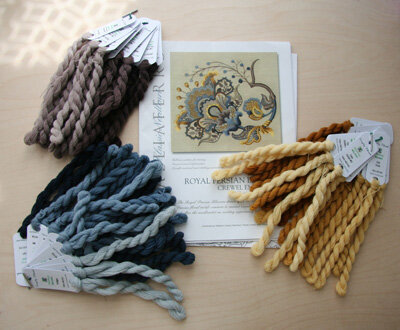 Well, I learned a couple of things during this long, drawn out process.Firstly, this is a big design and big designs take a long time to transfer. It's 14 inches/sq or 140 cm/sq. Not the fabric - the design.Secondly, there are a lot of details and details are tricky to transfer accurately.After framing up the twill, I copied the pattern onto tracking paper and pricked the design. I then placed it on the twill and applied the pounce. When I lifted the tracing paper up, what I saw horrified me - it was a big, gray mess in some places. After about 20 seconds, I realized that, in an effort to get all the details onto the fabric, I'd "over-transferred". (I just made that word up - pretty good, eh?)
Well, I learned a couple of things during this long, drawn out process.Firstly, this is a big design and big designs take a long time to transfer. It's 14 inches/sq or 140 cm/sq. Not the fabric - the design.Secondly, there are a lot of details and details are tricky to transfer accurately.After framing up the twill, I copied the pattern onto tracking paper and pricked the design. I then placed it on the twill and applied the pounce. When I lifted the tracing paper up, what I saw horrified me - it was a big, gray mess in some places. After about 20 seconds, I realized that, in an effort to get all the details onto the fabric, I'd "over-transferred". (I just made that word up - pretty good, eh?)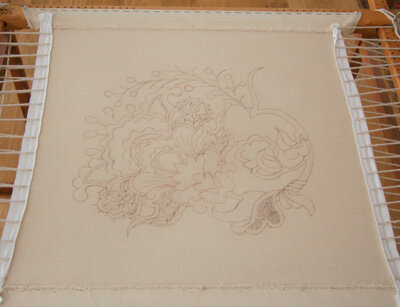 Where there were many beautifully shaped ovals on the paper design, there was a big gray splodge on the twill. Fortunately, pounce can be knocked right off so I walked out to the balcony and did so. Clean twill again, Whew! Then I spent about half an hour taping over all the tiny holes where I'd pricked the details of the design. Tedious. I pounced again and this time got only the outline of the large shapes. Great! Then, I took the brave step of drawing the details in free hand. Yes! Me! Freehand drawing! And it worked! As Nicola and Sarah said, one's drawing does get better with practice.The next step was to go through the stitch instructions and write in the numbers for all the wool I would be using. The wool that Talliaferro suggests is Appleton and all of those numbers are on the wool chart and in the instructions. However, they have done something really, really clever and provided spaces for you to write in a different brand of wool color numbers both on the chart and in the instructions.I'm using Heathway Crewel Wool from Catkin Crown Studio or Tristan Brooks for this project. Honestly, after having to do my entire RSN project with Appleton and throwing away countless lengths of wool because they were spun unevenly or broke or frayed or had pieces of straw in them, I just couldn't face using Appleton wool again. The Heathway Crewel Wool colors I'm using are Indigo, Old Gold and Fawn. I used my Appleton and Heathway thread cards to match the colors.
Where there were many beautifully shaped ovals on the paper design, there was a big gray splodge on the twill. Fortunately, pounce can be knocked right off so I walked out to the balcony and did so. Clean twill again, Whew! Then I spent about half an hour taping over all the tiny holes where I'd pricked the details of the design. Tedious. I pounced again and this time got only the outline of the large shapes. Great! Then, I took the brave step of drawing the details in free hand. Yes! Me! Freehand drawing! And it worked! As Nicola and Sarah said, one's drawing does get better with practice.The next step was to go through the stitch instructions and write in the numbers for all the wool I would be using. The wool that Talliaferro suggests is Appleton and all of those numbers are on the wool chart and in the instructions. However, they have done something really, really clever and provided spaces for you to write in a different brand of wool color numbers both on the chart and in the instructions.I'm using Heathway Crewel Wool from Catkin Crown Studio or Tristan Brooks for this project. Honestly, after having to do my entire RSN project with Appleton and throwing away countless lengths of wool because they were spun unevenly or broke or frayed or had pieces of straw in them, I just couldn't face using Appleton wool again. The Heathway Crewel Wool colors I'm using are Indigo, Old Gold and Fawn. I used my Appleton and Heathway thread cards to match the colors.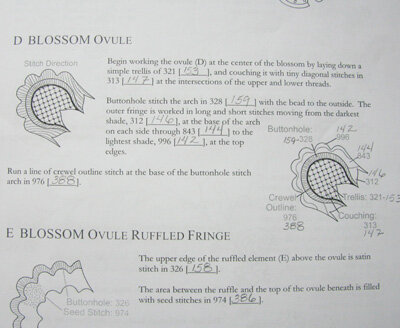 After transferring the design, it was time to set up to begin stitching. I have the slate frame but no trestles. I do, however, have two IKEA Molger wooden towel stands that I thought might work so I got them out and tried them and, they worked!
After transferring the design, it was time to set up to begin stitching. I have the slate frame but no trestles. I do, however, have two IKEA Molger wooden towel stands that I thought might work so I got them out and tried them and, they worked!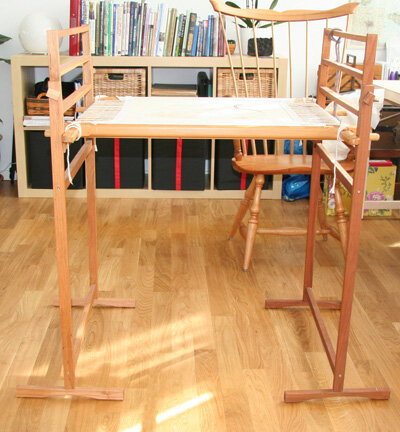 They need some modification to be perfect, but the general idea is right. Best of all, they're cheap; $20/£13.99/€13,99 each. I think drilling additional holes so the height is adjustable will make them just about perfect.
They need some modification to be perfect, but the general idea is right. Best of all, they're cheap; $20/£13.99/€13,99 each. I think drilling additional holes so the height is adjustable will make them just about perfect.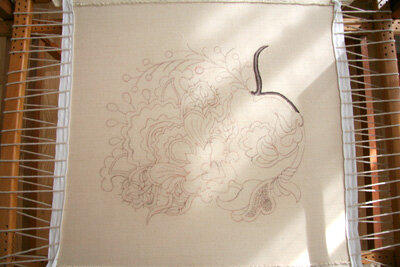 Once I was all set up, I started on the stem that anchors the whole flower. It's worked in shaded stem stitch and it's big. Here's a photo of the whole piece with part of the stem finished. I worked on this for about 3 hours. Really, it's huge!
Once I was all set up, I started on the stem that anchors the whole flower. It's worked in shaded stem stitch and it's big. Here's a photo of the whole piece with part of the stem finished. I worked on this for about 3 hours. Really, it's huge! This is the same technique I used on the trunk of the tree in my RSN piece. The difference is that in the Royal Persian Blossom the light is striking the stem in the middle of the stem and on my trunk the light is coming from the top. Therefore, the lightest thread is in the middle of the Royal Persian Blossom stem but on the top of my trunk.
This is the same technique I used on the trunk of the tree in my RSN piece. The difference is that in the Royal Persian Blossom the light is striking the stem in the middle of the stem and on my trunk the light is coming from the top. Therefore, the lightest thread is in the middle of the Royal Persian Blossom stem but on the top of my trunk.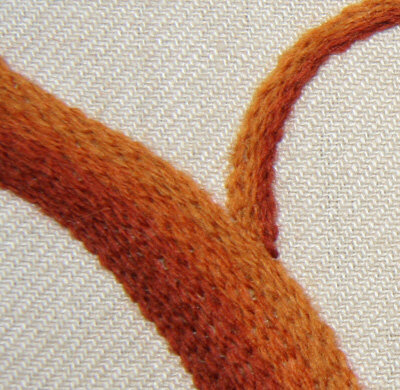 The shading has been done in both pieces to show where the light is coming from and how it's striking the shape in the piece. The direction from which the light comes is an important consideration when designing embroidery and these two examples show how different shading makes us 'see' the light sources differently.Do you consider the source of light in your designs when you stitch or design piece? How do you show light in your work? If you have any tips, let us know!
The shading has been done in both pieces to show where the light is coming from and how it's striking the shape in the piece. The direction from which the light comes is an important consideration when designing embroidery and these two examples show how different shading makes us 'see' the light sources differently.Do you consider the source of light in your designs when you stitch or design piece? How do you show light in your work? If you have any tips, let us know!